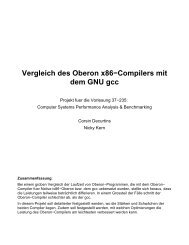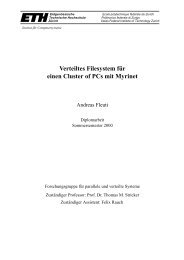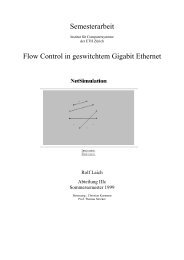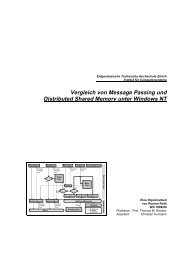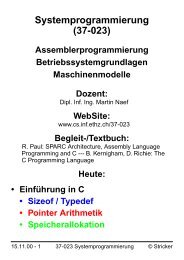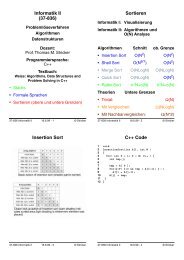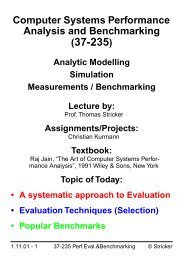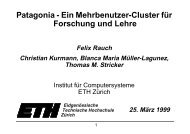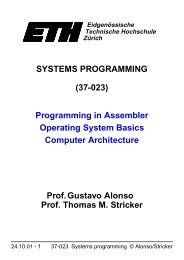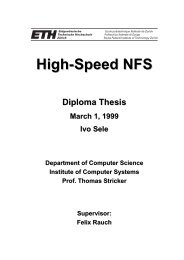serial communication controller (scc ™ sdlc mode of operation - Clips
serial communication controller (scc ™ sdlc mode of operation - Clips
serial communication controller (scc ™ sdlc mode of operation - Clips
Create successful ePaper yourself
Turn your PDF publications into a flip-book with our unique Google optimized e-Paper software.
Application NoteSerial Communication Controller (SCC ): SDLC Mode <strong>of</strong> OperationTHE SDLC LOOP MODE (Continued)Notes on Figure 6:1. The master SCC sends EOP by switching from flag onidle to mark on idle2. At initialization, all Slave stations were set up for SDLCloop <strong>mode</strong> At this point, the Slave station connects itsRxD pin to TxD pin with gate propagation delay, andstarts to monitor Rx data for the EOP sequence.3. On receiving the EOP, the slave generates anExternal/Status Interrupt with Break/Abort bit set. Aone bit time delay is inserted between RxD and TxD.(The GAOP,Go active on Poll, bit should be reset atthis point to avoid unexpected loop entry by the Slavetransmitter.) The Slave’s on-loop bit is set and thereceiver is in hunt <strong>mode</strong>.4. Note that there is a one bit time delay betweenreceived data and transmitted data.5. When the Slave wants to transmit it must first receivean EOP and have GAOP set.6. On receiving an EOP, the Slave interrupts withBreak/Abort clear. The EOP is converted to a flag, theloop sending bit is set, and the transmitter will sendflags until data is written into the Transmit Buffer.7. Note that the flags overlap.8. When the slave has sent all <strong>of</strong> its data the GAOP flagshould be cleared so that the CRC is sent onunderrun.9. When the closing flag has been sent the Slave revertsto a one bit delay, which produces another EOP.10. The master must keep its output marking until itsreceiver has received all frames sent by secondaries.CMOS SCC AND ESCCThe discussion above applies to the NMOS SCC and theCMOS SCC without the SDLC Frame Status FIFO feature.The CMOS version and the ESCC have a SDLC FrameStatus FIFO for easier handling <strong>of</strong> the SDLC <strong>mode</strong> <strong>of</strong><strong>operation</strong>. The SDLC Status FIFO is designed for DMAcontrolled SDLC receive for high speed SDLC datatransmission, or for systems whose CPU interruptprocessing is not fast.This FIFO is able to store up to 10 packets’ worth <strong>of</strong> bytecount (14-bit count) and status information(Overrun/Parity/CRC error status). To use this feature,simply enable this FIFO and let DMA transfer data tomemory. While DMA is transferring received data to thememory, the CPU will check the FIFO and locate the datain memory, as well as the status information <strong>of</strong> thereceived packet.Other ESCC enhancements make it easier to handle theSDLC <strong>mode</strong> <strong>of</strong> <strong>operation</strong>. These include:■■■■■■■■■Deeper FIFO (4 Bytes Transmit, and 8 Bytes receive)Automatic Opening Flag transmissionAutomatic EOM resetAutomatic /RTS deactivationFast /DTR//REQ <strong>mode</strong>Complete CRC receptionReceive FIFO Antilock featureProgrammable DMA and interrupt request levelImproved data setup time specificationFor more details on these functions, please refer to theSCC/ESCC Technical manual and related documents.CONCLUSIONThis application note describes the basic <strong>operation</strong> <strong>of</strong> theSCC in SDLC <strong>operation</strong>al <strong>mode</strong>s. With minor variations,most <strong>of</strong> these <strong>operation</strong>s also apply to the CMOS SCCwith Status FIFO enabled and the ESCC.6-104



